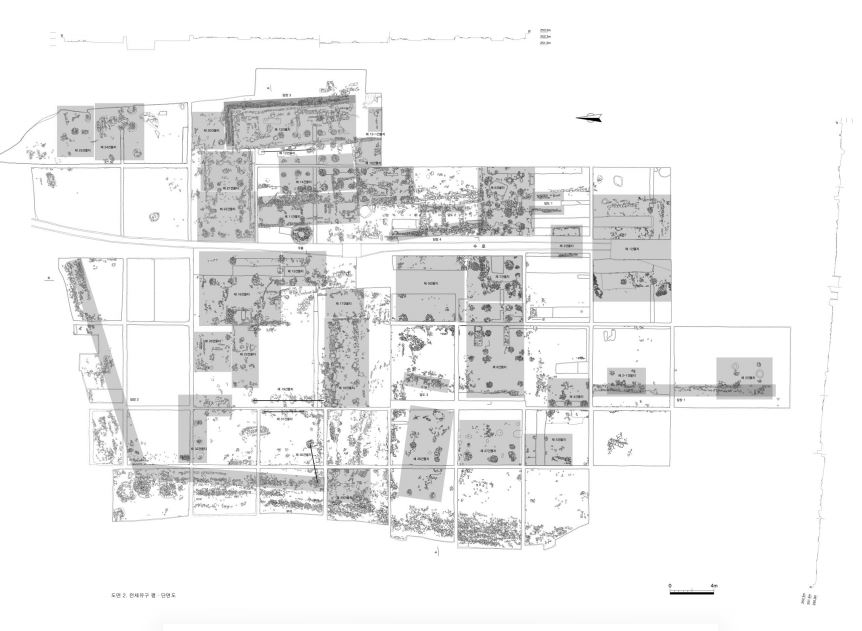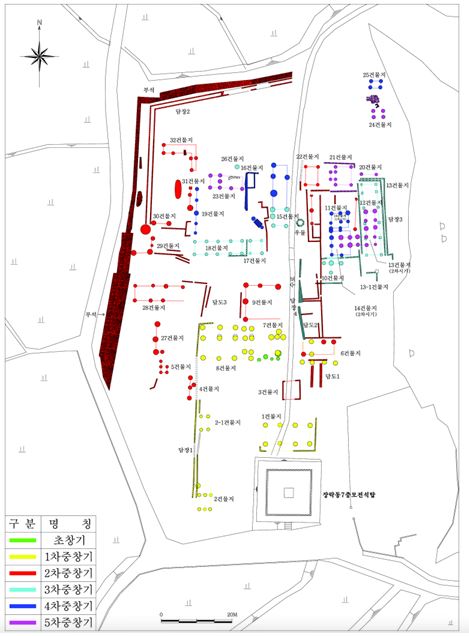제천 장락사지
| 장락사지 Jangnaksa Temple Site |
|
| 대표명칭 | 장락사지 |
|---|---|
| 영문명칭 | Jangnaksa Temple Site |
| 한자 | 長樂寺址 |
| 주소 | 충청북도 제천시 장락동 65-2 |
해설문
국문
장락사지는 충북 제천시 장락동 65-2번지 일원에 위치한 옛 절터이다. 장락사지는 삼국 시대에 세워진 후 조선 중기인 17세기에 없어졌다. 절은 다섯 차례에 걸쳐 고쳐 지어졌으며, 고려 시대에 가장 번성했다. 조선왕조실록의 기록과 고려 중기에 제작된 ‘장長’ 자가 새겨진 평기와를 토대로 장락사라는 이름은 고려 중기부터 사용된 것으로 추정하고 있다.
절터에 대한 상세한 정보는 2003년부터 2008년까지 한 차례의 시굴 조사와 세 차례의 발굴 조사를 통해 밝혀졌다. 조사 과정에서 34개동의 건물터, 담장이 있던 자리, 통행로, 우물 등 건물의 구조와 양식을 알 수 있는 자취가 확인되었다. 기와류, 토기류, 자기류, 철제류, 청동류, 비석 등의 유물이 출토되었는데 고려 시대의 유물이 가장 많았으며, 조사 지역 전체에서 고려 시대의 건축 흔적이 발견되었다.
장락사지는 제천 지역에서 최초로 확인된 삼국 시대의 불교 유적이라는 점에서 의미가 있다. 또한 함께 발굴된 연꽃무늬 수막새 등의 유물이 6세기 후반에 제작된 것으로 추정되고 있어 고대의 문화 전파 경로와 제천 지역의 역사 연구의 중요한 자료로 평가되고 있다.
영문
Jangnaksa Temple Site
This is the former site of Jangnaksa Temple which was built during the Three Kingdom period (57 BCE-668 CE) and remained functional until the 17th century. It is the first archeological site of the Three Kingdom period that is related to Buddhism to have been discovered in the Jecheon area.
Over its history, Jangnaksa Temple underwent five expansions and reached its heyday during the Goryeo period (918-1392). According to the Annals of the Joseon Dynasty, in 1407, King Taejong (r. 1400-1418) designated 88 famous Buddhist temples across the country as responsible for praying for peace and prosperity of their corresponding areas. Jangnaksa Temple was chosen to represent the Jeju (today’s Jecheon) area.
Between 2003 and 2008, one archeological survey and three excavations were conducted on this site. The excavations revealed a large number of structural remains including 34 building sites, an enclosure wall site, a passage site, and a well site. Other findings include roof tile shards, earthenware, porcelain, metalware, bronzeware, and stone monuments which can be dated back to different periods between the Three Kingdom and Joseon (1392-1910) periods, while the largest amount of artifacts belong to the Goryeo period. A particularly noteworthy find providing a glimpse at the cultural exchange in the ancient world is the convex roof-end tiles with lotus designs presumed to have been made in the late 6th century.
The stone brick pagoda on the southern end of the site is presumed to have been built during the Unified Silla period (668-935) and was designated as a Treasure in 1967. The current Jangnaksa Temple located on the right side of its former site was newly built in the 1970s.
영문 해설 내용
이곳은 삼국시대에 창건되어 조선시대인 17세기까지 유지되었던 사찰 장락사의 옛 터이다. 제천 지역에서 최초로 확인된 삼국시대의 불교유적이라는 점에서 의미가 있다.
장락사는 총 다섯 차례에 걸쳐 중창되었으며, 고려시대에 가장 번성했다. 『조선왕조실록』에 따르면 1407년 태종(재위 1400-1418)이 전국 88개 고을을 대표하는 명찰을 택하여 각 고을의 평화와 안녕을 기원하는 사찰로 지정했는데, 이때 제주(제천의 옛 이름)에서는 장락사가 지정되었다.
2003년부터 2008년까지 한 차례의 시굴 조사와 세 차례의 발굴 조사가 실시되었다. 조사 과정에서 34개동의 건물터, 담장이 있던 자리, 통행로, 우물 등 건물의 구조와 양식을 알 수 있는 자취가 확인되었다. 유물로는 삼국시대에서 조선시대에 이르는 기와류, 토기류, 자기류, 철제류, 청동류, 비석 등이 출토되었으며, 고려시대의 유물이 가장 많았다. 6세기 후반에 제작된 것으로 추정되는 연꽃무늬 수막새는 고대의 문화 전파 경로와 제천 지역의 역사 연구의 중요한 자료로 평가되고 있다.
장락사지 가장 남쪽에 서 있는 모전석탑은 통일신라시대에 세워진 것으로 추정되며, 1967년 보물로 지정되었다. 장락사지 오른편에 위치한 지금의 장락사는 1970년대에 새로 지은 것이다.
갤러리
참고자료
- 태종실록 14권, 태종 7년 12월 2일 신사 2번째기사 (1407년 명 영락(永樂) 5년) 「여러 고을의 복을 빌던 절을 명찰을 대신 지정하다」http://sillok.history.go.kr/id/kca_10712002_002


